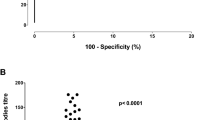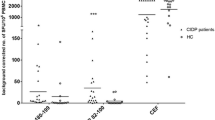Abstract
Introduction
Previous studies have shown the existence of either cellular or humoral MBP-reactive elements up to 5 years after spinal cord injury (SCI), but not the presence of both after 10 years.
Materials and methods
Twelve SCI patients, with more than 10 years of evolution, and 18 healthy blood donors were studied. Lymphocyte proliferation (colorimetric-BrdU ELISA assay) and antibody titers against MBP (ELISA Human IgG MBP-specific assay) were assessed.
Results
SCI patients presented a significant T-cell proliferation against MBP (lymphocyte proliferation index: 3.7 ± 1.5, mean ± SD) compared to control individuals (0.7 ± 0.3; P < 0.001). Humoral response analysis yielded a significant difference (P < 0.0001) between the antibody titers of controls and SCI patients. A significant correlation between cellular and humoral responses was observed. Finally, patients with an ASIA B presented the highest immune responses.
Conclusion
This work demonstrates, for the first time, the existence of both cellular and humoral responses against MBP in the chronic stages (>10 years) of injury.



Similar content being viewed by others
References
Chiu WT, Lin HC, Lam C et al (2010) Epidemiology of traumatic spinal cord injury: comparisons between developed and developing countries. Asia Pac J Public Health 22:9–18
Rowland JW, Hawryluk GW, Kwon B et al (2008) Current status of acute spinal cord injury pathophysiology and emerging therapies: promise on the horizon. Neurosurg Focus 25:E2
Ibarra A, Correa D, Willms K et al (2003) Effects of cyclosporin-A on immune response, tissue protection and motor function of rats subjected to spinal cord injury. Brain Res 979:165–178
Popovich PG, Stokes BT, Whitacre CC (1996) Concept of autoimmunity following spinal cord injury: possible roles for T lymphocytes in the traumatized central nervous system. J Neurosci Res 45:349–363
Kil K, Zang YCQ, Yang D et al (1999) T cell response to myelin basic protein in patients with spinal cord injury and multiple sclerosis. J Neuroimmunol 98:201–207
Mizrachi Y, Ohry A, Aviel A et al (1983) Systemic humoral factors participating in the course of spinal cord injury. Paraplegia 21:287–293
Hayes KC, Hull TC, Delaney GA et al (2002) Elevated serum titers of proinflammatory cytokines and CNS autoantibodies in patients with chronic spinal cord injury. J Neurotrauma 19:753–761
Popovich PG, Guan Z, McGaughy V et al (2002) The neuropathological and behavioral consequences of intraspinal microglial/macrophage activation. J Neuropathol Exp Neurol 61:623–633
Jones TB, Basso DM, Sodhi A et al (2002) Pathological CNS autoimmune disease triggered by traumatic spinal cord injury: implications for autoimmune vaccine therapy. J Neurosci 22:2690–2700
Shechter R, London A, Varol C et al (2009) Infiltrating blood-derived macrophages are vital cells playing an anti-inflammatory role in recovery from spinal cord injury in mice. PLoS Med 6:el000113
Ibarra A, García E, Flores N et al (2010) Immunization with neural-derived antigens inhibits lipid peroxidation after spinal cord injury. Neurosci Lett 476:62–65
Ziv Y, Avidan H, Pluchino S et al (2006) Synergy between immune cells and adult neural stem/progenitor cells promotes functional recovery from spinal cord injury. PNAS 103:13174–13179
Racke MK, Lovett-Racke AE (2011) Glatiramer acetate treatment of multiple sclerosis: an immunological perspective. J Immunol 186:1887–1890
Kipnis J, Nevo U, Panikashvili D et al (2003) Therapeutic vaccination for closed head injury. J Neurotrauma 20:559–569
Martiñon S, Garcia E, Flores N et al (2007) Vaccination with a neural-derived peptide plus administration of glutathione improves the performance of paraplegic rats. Eur J Neurosci 26:403–412
Beck KD, Nguyen HX, Galvan MD et al (2010) Quantitative analysis of cellular inflammation after traumatic spinal cord injury: evidence for a multiphasic inflammatory response in the acute to chronic environment. Brain 133:433–447
Cox AL, Coles AJ, Nortje J et al (2006) An investigation of auto-reactivity after head injury. J Neuroimmunol 174:180–186
Ibarra A, Jiménez A, Cortes C et al (2007) Influence of the intensity, level and phase of spinal cord injury on the proliferation of T cells and T-cell-dependent antibody reactions in rats. Spinal Cord 45:380–386
Acknowledgments
This work was partially supported by the National Council of Science and Technology of Mexico (CONACYT), grant no. 57204. We would like to thank M.Sc. Fela Mendlovic for providing technical assistance.
Conflict of interest
None
Author information
Authors and Affiliations
Corresponding author
Rights and permissions
About this article
Cite this article
Zajarías-Fainsod, D., Carrillo-Ruiz, J., Mestre, H. et al. Autoreactivity against myelin basic protein in patients with chronic paraplegia. Eur Spine J 21, 964–970 (2012). https://doi.org/10.1007/s00586-011-2060-7
Received:
Revised:
Accepted:
Published:
Issue Date:
DOI: https://doi.org/10.1007/s00586-011-2060-7




